Rural Living At Its Best
| Adams Crabapple New foliage emerges with a red tint in spring, turns green in summer, and changes to beautiful orange-red in fall. Pink flowers are followed by red fruit that clings through winter providing food for birds without making a mess. Grows – 10 to 20′ tall with a parkway spacing of 2′ – 4′ |  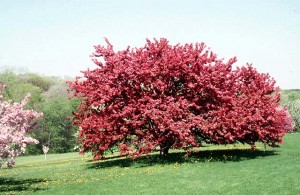 | |
| Centurian Crabapple Leaves emerge reddish in spring turning to bronze-green in summer. Rose red flowers are followed by glossy red fruit. Upright, somewhat narrow form. This crabapple has very large flowers and is quite showy. Grows 12′ to 20′ tall. Needs parkway spacing of 2′ – 4′ |  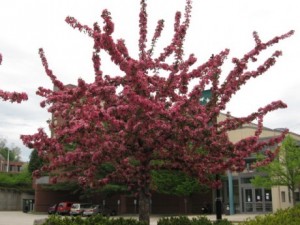 | |
| Kelsey Crabapple The purple-pink blooms of this Canadian crab have white markings at the base of each of its 16 petals. Named Manitoba’s Centennial Tree, it bears bronze-green foliage and persistent, dark purple fruit.Grows 10′ to 18′ and requires a parkway spacing of 2′ to 4′ |  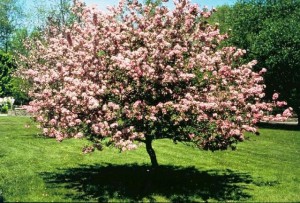 | |
| Prariefire Crabapple Beautiful! Reddish-magenta blossoms cover an upright, spreading tree in spring followed by maroon, cone shaped fruit. Bark is glossy dark red. Excellent disease resistance. NOT a messy tree. This berry-sized fruit hangs onto the tree throughout the winter providing a good food source for birds. Attractive, bright red berries are very showy in winter.Grows 15′ to 20′ and requires a 2′ to 4′ parkway space |  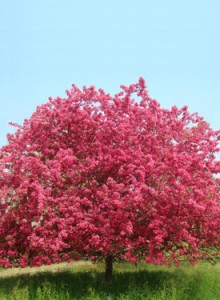 | |
| Radiant Flowering Crabapple The Radiant crabapple tree, Malus “Radiant”, produces crimson buds that open to single, striking pink flowers that will light up your landscape. This tree puts on a spectacular spring show. It produces 1/2 inch bright red fruits in the fall. The new foliage has a reddish tint which ages to green. Performing best in full sun, it is a fast-growing compact, symetrical crown and is very hardy. It performs best in moderately moist, acidic, well-drained soil. This tree is very disease resistant to scab, cedar-apple rust, mildew and fire blight. It is grown for cider, cooking, eating or a combination of uses. Prune in spring to maintain shape and structure.Grows 15′ to 20′ and requires a 2′ to 4′ parkway |  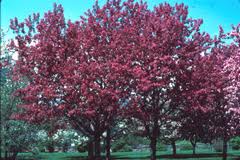 | |
| Serviceberry Serviceberry has a slow to moderate growth rate, and an upright to oval or rounded growth form. It is tolerant to a wide range of environmental conditions, and has no serious disease or pest problems (certain insects will occasionally feed on the leaves). It has white flowers in early spring (normally April) and yellow to orange or red fall color. It will produce small fruits that are usually eaten by birds before they fall. A number of cultivars are available, including: Autumn Brilliance, Cumulus, Robin Hill. Grows less than 25′ tall and requires a 2′ – 4′ parkway. |  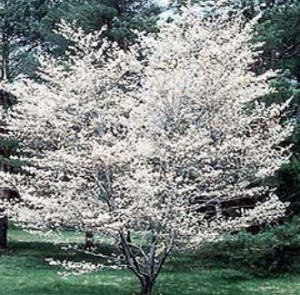 | |
| Sugar Tyme Crabapple This disease resistant crab was a 1999 Michigan Grower’s Choice Award winner. It has crisp green foliage and pale buds that open to snowy white flowers which completely cover the tree. Spectacular in the landscape as the rich red fruits remain on the tree all year. Grows 10′ to 18′ and requires a parkway space of 2′ to 4′ |  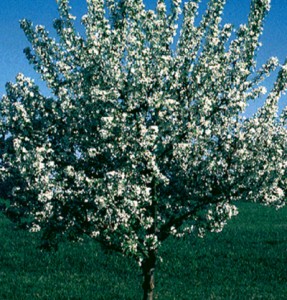 | |
| Amur Maackia Amur Maackia is a medium-size flowering tree with a relatively slow rate of growth and rounded form. It prefers relatively slow rate of growth and rounded form. It prefers well-drained soil, but is tolerant to a wide range of environmental conditions. It has no serious disease or pest problems. The bark hs an attractive olive-green to golden-brown color, and leaves turn yellow in fall. Racemes of small white flowers usually appear in July.Grows 25′ to 35′ and requires a 3′ to 6′ parkway space. |  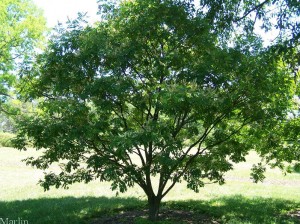 | |
| Elizabeth Magnolia Medium size deciduous trees with beautiful tulip flowers. This cultivars has white flowers. Blooms in mid-spring before it leafs and may have some blooms in the summer.Grows 15′ to 20′ and requires a 3′ to 6′ parkway space. | 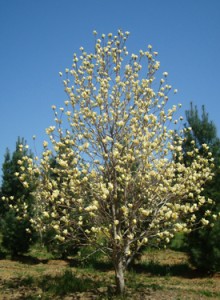  | |
| European Hornbeam European Hornbeam is a relatively slow-growing tree with dense branching and rounded form at maturity. Some cultivars have a narrow upright growth form. It prefers well-drained soil with adequate moisture, but will tolerate clay soil (if not overly wet). It will grow larger than American Hornbeam. Fall color is usually white or yellow-brown.Grows 25′ to 30 and requires a 3′ to 6′ parkway space |  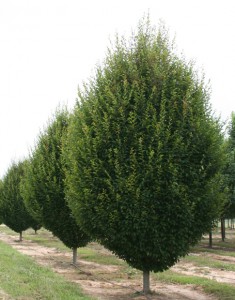 | |
| Galaxy Magnolia Medium size deciduous trees with beautiful tulip flowers. This cultivars has bright red purple flowers. Blooms in mid-spring before it leafs.Grows 15′ to 20′ and requires 3′ to 6′ parkway space. |  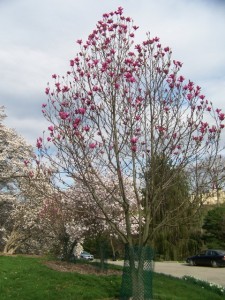 | |
| Ginkgo “Princeton Sentry” Native to China but once grew world wide. This cultivars has an interesting leaf form that is different than the other ginkgos. The fall color is not as good. Great street trees with great fall color. They work well around other hardscape, are adaptable to urban conditions and there are not currently any disease or pest problems.Grows 25′ to 30′ and requires a 4′ to 6′ parkway space. |  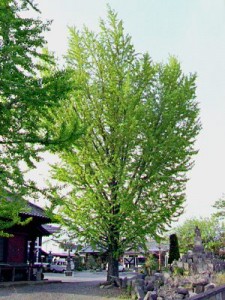 | |
| Harvest Gold Crabapple Upright, oval crown makes this cultivar well suited as an ornamental street tree. Features showy white flowers and brightly colored yellow fruit.Grows 25′ to 30′ and requires 4′ to 6′ parkway space. |  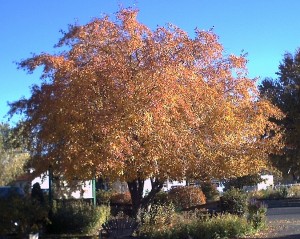 | |
| Hedge Maple Hedge Maple is a medium-sized tree with a slow to moderate rate of growth, with an upright form in youth becoming rounded with age. It has no serious pest or disease problems, and is tolerant to a wide range of environmental conditions. It will produce seeds. Fall color is usually yellow.Grows 25′ to 35′ and requires a 3′ to 6′ parkway space. |  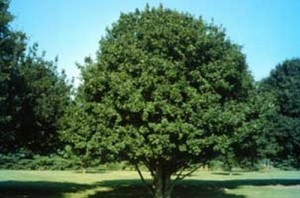 | |
| Kousa Dogwood This handsome tree add year-round beauty. White flowers in May and June give it a milky way effect; purple and scarlet fall leaves add intense color. Beautiful tree form with horizontal branching. Partial shade to full sunGrows 15′ to 25′ and requires a 3′ to 6′ parkway space. |  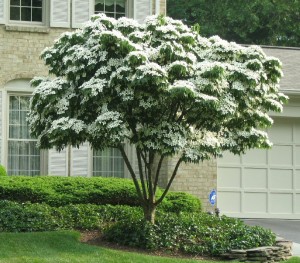 | |
| Red Dogwood Red flowers in spring and reddish-purple leaves in the fall. The glossy-red fruits provide food for songbirds. Stems are a soft gray and bark is scaly. Partial shade; moist, acid, well-drained soil.Grows 15′ to 25′ and requires a 3′ to 6′ parkway space. |  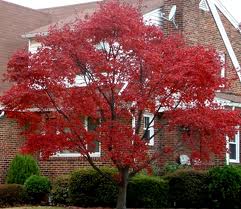 | |
| Trident Maple Native to China. Small tree with a height of 20-25 feet. Adaptable to urban conditions. Good tree for tight locations and under utility lines. Displays a nice red or orange fall color.Grows 20′ to 25′ and requires a 3′ to 6′ parkway space. |  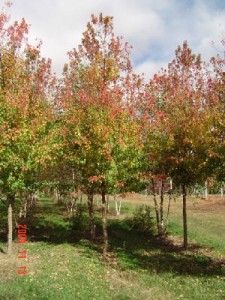 | |
| Turkish Filbert Turkish Filbert has a relatively slow rate of growth, and upright to pyramidal form. It is tolerant to a wide range of environmental conditions, and has no serious disease or pest problems, although gypsy moth caterpillars and fall webworms will sometimes feed on the leaves. Fall color is usually yellow. Larger trees will produce small thick-shelled nuts (hazels) if cross-pollinated. Grows 34′ to 45′ and requires a 3′ to 6′ parkway space. |  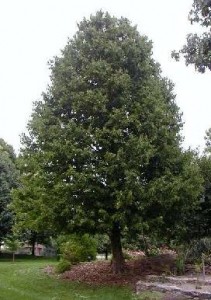 | |
| White Dogwood An excellent landscape choice in all four seasons. Flowers are showy in spring. Leaves turn red-purple in fall. Glossy red fruits attract winter songbirds. Likes partial shade; moist, acid, well-drained soil.Grows 20′ to 25′ requires a 4′ to 6′ parkway space. |  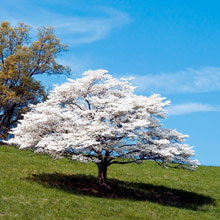 | |
| “Glenleven” Linden Glenleven Linden has a moderate growth rate and relatively upright form of maturity, although many young trees may be as wide as tall. It does not have any serious disease or pest problems, but gypsy moth caterpillars and Japanese beetles will sometimes feed on the foliage. Fall color is usually yellow.Grows over 45′ and requires 6′ to 8′ of parkway space. |  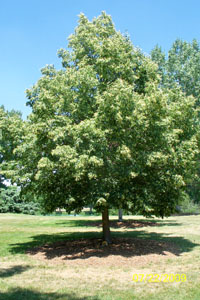 | |
| Aristocrat Flowering Pear A fine upright, pyramidal, to broad-pyramidal form, it has a nice fall color that varies from yellow to red. Much larger than the common Cleveland and Chanticleer Pears but has the same fragrant white blooms that are profuse in teh spring.Grows 35′ to 50′ and requires a 6′ to 8′ parkway space. |  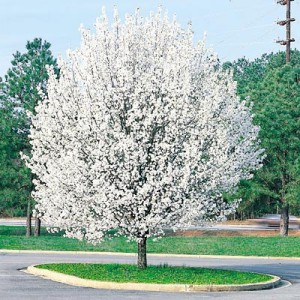 | |
| Autumn Purple Ash Native to Eastern US. Fairly fast-growing tree. Has a wonderful purple fall color. Handles heat well. Likes water and makes a better turf parkway tree than a concrete cutout.Grows 35′ 40′ and requires a 6′ to 8′ parkway space. |  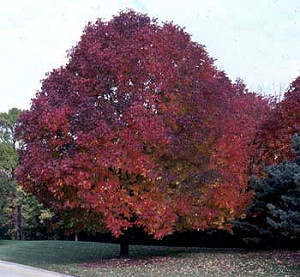 | |
| Black Maple Black Maple has a slow to moderate growth rate with an upright to oval shape in youth, becoming rounded with age. It performs best in well-drained soild with adequate moisture and dislikes heavy clay and restricted rooting space, although it is somewhat more tolerant of poor soil conditions than sugar maple. It does not have any serious disease or pest problems. It will produce seeds. Fall color is yellow.Grows over 45′ and requires a 6′ to 8′ parkway space. |  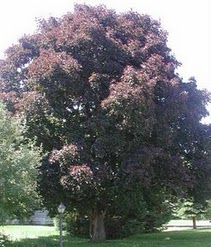 | |
| Chinquapin Oak A worthy specimen for larger lawns, estates, or parks. A medium to large size oak with 4?-6 1/2? glistening dark green leaves in summer turning yellow-orange to orangish-brown in fall. Produces 1? sweet acorns that mature in a single season. The acorns are at the top of the food preference list for many wildlife species. The bark is an ashy light gray that breaks into narrow, thin flakes. As this species matures, it becomes a magnificent specimen and a conversation piece.Grows 40′-50′ and requires a 6′ to 8′ parkway space. |  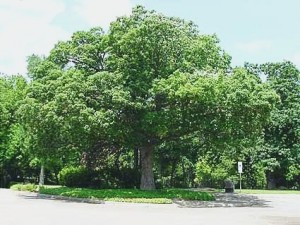 | |
| Cleveland Flowering Pear A fine upright, narrow pyramid shaped tree. Perfect for smaller yards where space is limited. Abundantly produced white flowers in early spring. It has thick green shiny leaves in the summer that turn a spectacular array of orange to red in the fall. A very water thrifty tree.Grows 25′ to 35′ and requires 4′ to 6′ parkway space. |  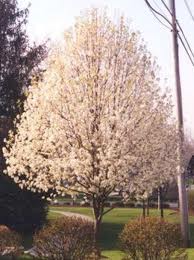 | |
| Common Hackberry It grows to 50 feet with a rounded crown just as wide. The Hackberry tolerates har, wind, alkaline soil and urban pollution. It is a good replacement tree for the American Elm because of its similar form and adaptability. Hardy in all zones. Leaves are bright green, oval finely toothed and 2 to 5 inches in length. The berries attract birds as a source of food in the winter. Grows 35′ to 40′ and requires a 6′ to 8′ parkway space. |  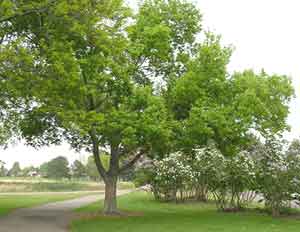 | |
| Crimean Linden Crimean Linden has a moderate rate of growth and an upright or pyramidal form in youth, becoming rounded wtih age. It prefers well-drained soil, but is tolerant to a wide range of environmental conditions. It has no serious disease or pest problems, but gypsy moth caterpillars and japanese beetles will sometimes feed on the leaves. Crimean Linden has glossier leaves than most other Lindens and yellow fall color.Grows over 45′ and requires a 6′ to 8′ parkway space. |  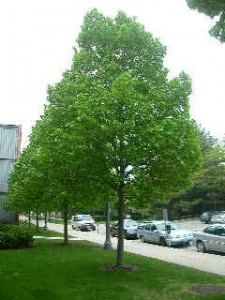 | |
| European Beech The European Beech is a beautiful tree year-round. The leaves are a shimmering green when unfolding, turning to a dark green in summer. Lustrous rich russet brown and gold bronze in fall. Dense, upright, oval form. Prefers moist, well-drained soil and full sun.Grows 50′ to 60′ and requires a 6′ to 8′ parkway space. |  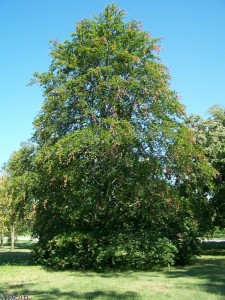 | |
| Ginkgo “Saratoga” Native to China but once grew world wide. This cultivars has an interesting leaf form that is different that the other gingkos. The fall color is not as good. Great street trees. Leaves turn gold and drop all at once. They work well around hardscape and are adaptable to urban conditions.Grows 25′ to 30′ and requires a 4′ to 6′ parkway space. |  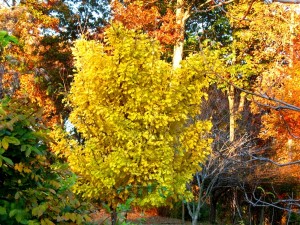 | |
| Ginkgo “Shangri-La” Green in Summer; Yellow in Fall; broadleaf, deciduous; fan shaped leaves. Unnoticeable flowers bloom in Spring; fruit is 3/4 – 1 1/2?, tan; female trees produce odor-like fragrance & slippery.Grows 25′ to 30′ and requires a 4′ to 6′ parkway space. |  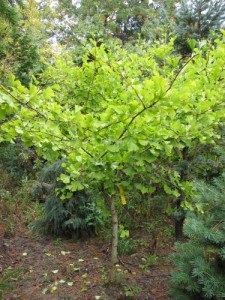 | |
| Harvest Gold Linden Harvest Gold Linden has a moderate growth rate and a relatively upright form as a young tree, becoming rounded with age. It does not have any serious disease or pest problems, but gypsy moth caterpillars and japanese beetles will sometimes feed on the foliage. The leaves are resistant to mites and fungal leaf spot. Harvest Gold has greater tolerance to cold and better fall color (usually yellow) than many the other Lindens currently available. Flowers and seeds are produced in smaller amounts than most other Lindens.Grows over 45′ requires a 6′ to 8′ parkway space. |  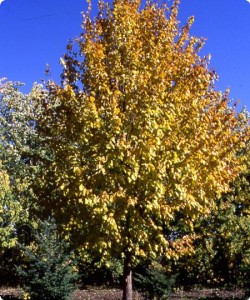 | |
| Katsura Katsura is a relatively slow-growing, long-lived tree with upright or oval form in youth, becoming rounded with age. It prefers well-drained soil with adequate moisture, and will not perform well in dry or poorly-drained soil. It has no serious disease or pest problems. Fall color is usually yellow.Grows over 45′ and requires a 6′ to 8′ parkway space. |  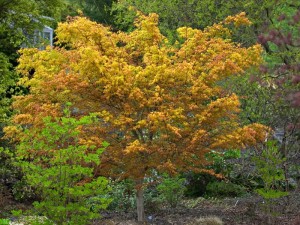 | |
| Musashino Native to Eastern Asia. Medium to large, moderate to fast growing tree. Can reach a height of 45′. Has smooth gray bark and narrow, oval, saw-toothed leaves. This cultivars is very upright and only spreads 20′. Ideal for tight locations.Grows 35′ to 45′ and requires a 6′ to 8′ parkway space. |  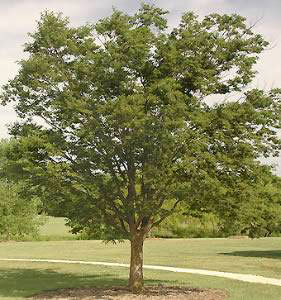 | |
| Red Oak Medium to large tree can reach 70′. Leaves are matte dark green and has a wonderful red fall color. Deep rooted. Grows 35′ to 40′ and requires a 6′ to 8′ parkway space. | No Picture Available | |
| Redspire Flowering Pear Beautiful ornamental tree. When in bloom is a mass of large white flowers. Foliage is glossy green changing to glowing shades of crimson and purple in the fall. Fruit is brownish. Pyramidal form. Grows 25′ to 35′ and requires a 6′ to 8′ parkway space. |  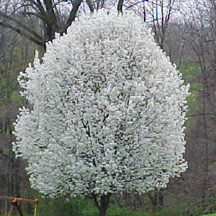 | |
| Shumard Oak Medium to large tree can reach 70′. Tolerates urban conditions. Has a dependable fall color in orange and reds. Grows 35′ to 40′ and requires a 6′ to 8′ parkway space. |  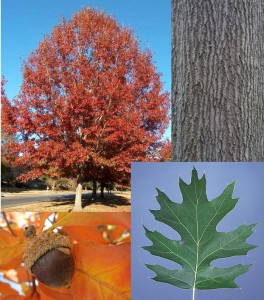 | |
| Silver Linden Silver Linden has a moderate rate of growth, with a somewhat upright form as a young tree, becoming rounded with age. It has dense branching and casts relatively heavy shade. Leaves are dark green on the upper surface and silvery whiteish below. It does not have any serious disease or pest problems, but gypsy moth caterpillars and japanese beetles will sometimes feed on the foliage. Fall color is usually yellow. Grows over 45′ and requires 6′ to 8′ of parkway space. |  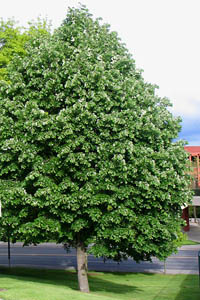 | |
| Sugar Maple Sugar Maple has a slow to moderate growth rate, with an upright to oval shape in youth becoming rounded with age. It performs best in well-drained soil with adequate moisture, and dislikes heavy clay and restricted rooting space. It does not have any serious disease or pest problems. Fall color varires from yellow to orange or red. Sugar Maple will produce seeds. Grows over 45′ and requires a 6′ to 8′ parkway space. |  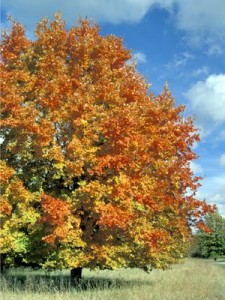 | |
| Tulip Tree A large fast growing tree that flowers in late spring. Aphids can be a problem but all in all a good street tree. Grows 35′ to 40′ and requires a 6′ to 8′ parkway space. |  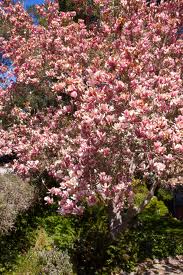 | |
| Village Green Elm Family: Ulmaceae. Village Green Zelkova is a large vase-shaped shade tree, with resistance to Dutch Elm disease plus ornamental bark, clean summer foliage, fall color, and fine-textured twigs, making it a viable substitute for the American Elm. USDA Hardiness zone 4-5Grows 35′ to 40′ and requires a 6′ to 8′ parkway space. |  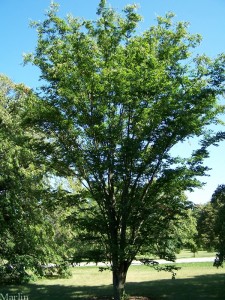 | |
| Willow Oak Broadly spreading, deciduous tree to 90′. Leaves are narrowly oblong, smooth, bright green. The bark is gray and smooth, no fall color.Grows 35′ to 40′ and requires a 6′ to 8′ parkway space. |  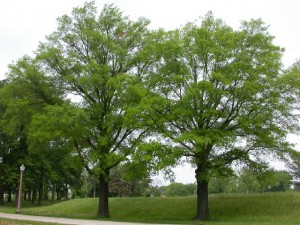 |